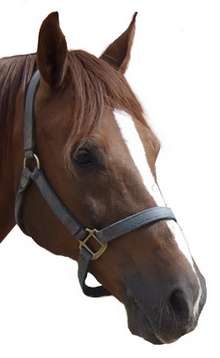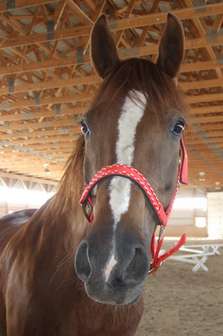Every horse owner must know how to halter horses and ponies. This article explains what a halter is, how to put one on a horse or pony, and how to size a halter.
by Adrianne Lake
You’ll quickly discover that halters and lead lines are two ingenious pieces of equipment you must learn to use when working with horses.
The Halter
The halter (or headcollar) is a harness that fits on the horse’s head around the muzzle and over the poll behind the ears. They can vary from quality and price. Generally used are the economy nylon halter and the classical leather halter. A lead line is attached to the halter under the chin to lead or tie a horse or pony. They come in different sizes and colours and are easily washed and durable. It’s wise to have an extra halter kicking around the barn because you’ll never know when it’ll come in handy.
Rope halters are also available and are used for training. A thick nylon halter is easy to push and pull against but a rope halter teaches horses to yield from pressure. Horses should not be tied up or left unsupervised in a rope halter. They catch easily and can be dangerous if used improperly. A simple nylon or leather halter does better for simple handling, leading and tying.
Some people leave halters on their horses most of the time regardless whether they are outside or in a stall. This is a bad idea because halters catch and don’t break. Many horses have injured or killed themselves wearing their halters. If the horse has catching issues a better solution is to leave the animal in a special break away halter until you can properly train the horse. As a rule, always remove the halter when turning a horse out or leaving it in a stall.
Putting a Halter on a Horse or Pony

Comfortable halter used for every day activities, but removed for release in the pasture or when the horse is stabled.
For the purposes of this article I’m going to assume your horse is trained, in a stall or easy to catch. Please note that the handling of horses is classically done the animal’s left side. While this is the proper way to handle horses in most stables, it’s good to be capable of handling (haltering, leading, etc.) horses on both sides.
1. Have a halter clipped to a lead line in your hands (make sure the halter is the right size!).
2. Acknowledge your horse and stand at his left side and loosely loop the lead line over his neck. (near side). This gives you a little control over the horse if he should try to pull away.
3. Start by reassuring the horse with your right hand. Slide your right hand around to the animal’s right side to guide the head.
4. With the unbuckled halter in your left hand, position the halter near the horses head. Then with your right hand, slide the noseband over the muzzle and guide the headstall over the ears. Take care not to accidentally poke the horses eyes.
5. Make sure the halter is placed correctly and securely. Use both hands to buckle the halter loosely under the throatlatch. Some halters have buckles, others have clips and rope halters are tied in a special knot.
6. Grasp the lead line attached to the halter about a foot or two away from the horses chin with your right hand. Grasp the remaining lead line folded in your left hand. Never wrap or tie a lead line around your hand. Take care to stand to the side of the horse at all times. You are now ready to go.
Sizing Halters
Halters come in various sizes including full, pony, cob, arab, draft and warmblood. To measure a horse for a halter size, measure below the cheekbone around the nose. Then measure from where you would like the noseband to lie (under the cheekbone) up around the ears and down the other side. An easy way of doing this is to use string for the measurements. Then measure the string. It’s not wise to measure a horse using a metal measuring tape.
All of this may sound complicated but with practice, it soon becomes second nature for you and your horse.
